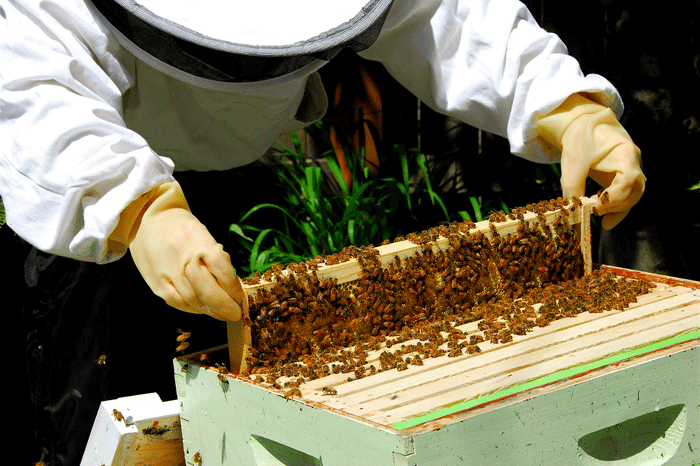Apitherapy on the table at the May 2012 Beekeeping Seminar
YOU WOULD THINK everyone would want to avoid being stung by bees – especially with the proliferation of more vicious Africanized bees in Florida. But bee stings, or rather bee venom, can be a good thing. Just ask Robert Messineo.
Messineo suffers from multiple sclerosis, an autoimmune disease that can affect muscles, eyes, hearing, speech, walking, and more. He gets at least ten bee stings a day as therapy. “Bee stings can cure almost any disease,” he says. “If you need a cortisone shot, you give yourself a bee sting. It does the same thing.”
While cortisone also helps, side effects can limit the number of injections you receive. “With bee stings, you can do 500 if you want,” he explains. “The pharaohs used bee stings to get rid of arthritis. This method of treatment is more than 5,000 years old. It’s extremely ancient.”
Messineo estimated he’s done more than 30,000 stings since 2005, when his neurologist advised him to have an operation for a bulging disc. After treating himself with 20 bee stings in the neck and shoulder, the bulging went away. He also was able to resume driving after the venom gave him relief from eye problems.
Bee therapy or apitherapy, the medicinal use of products made from the honeybee, such as bee venom, honey, pollen, royal jelly, and beeswax, was on the agenda at the May 2012 Beekeeping Seminar held at the University of Florida’s Institute of Food and Agricultural Sciences (IFAS) Extension Office in Bartow.
Approximately 85 people attended the event aimed at new and prospective beekeepers, which was held in partnership with the Bartow-based Ridge Beekeepers Association. Messineo helped present the program that included stations on starting a hive, hive construction, honey extraction, bee transport, Queen bees, nectar sources, wax rendering, looking inside the hive, and of course, apitherapy.
Although the venom has helped Messineo, it is poisonous and not generally recommended. “The reaction can vary by person,” says Mary Beth Henry, a UF/IFAS Extension agent working with small farms and pesticide licensing. “It’s not an ‘everybody’s-going-to-do-this’ sort of thing. Some people are allergic to bee stings.”
Honeybees help farmers with pollination, making it an important aid in food production. Pollination is where David Smith, who taught at a workshop station on splitting colonies, makes most of his money through beekeeping. “Honey is a bonus if I make it,” he says.
Smith, who maintains bee yards for the Ridge Beekeepers and Tampa Bay Beekeepers associations, estimates it would cost a hobbyist $1,000 to $1,500 to set up, “unless they can find good used equipment.”
Hives cost between $125 and $150 and can average 200 to 300 pounds of honey annually. Honey generates $1.50 to $1.90 a pound wholesale, he says.
Smith says he tries to use common sense and avoids stirring up the bees when he’s maintaining a hive. He also wears protective gear. “I get stung quite a bit,” he admits, “I run a little bit meaner stock. … It produces honey better.”
CREDIT
article by CHERYL ROGERS

